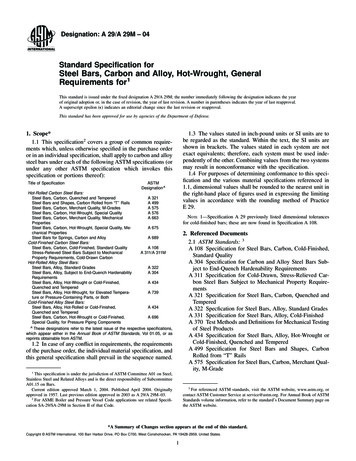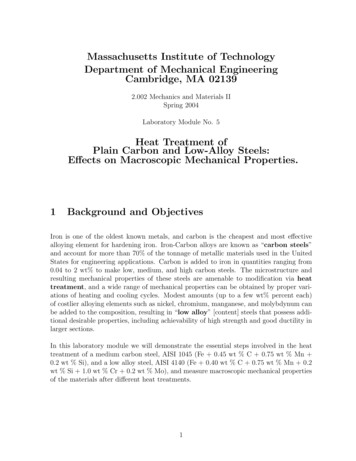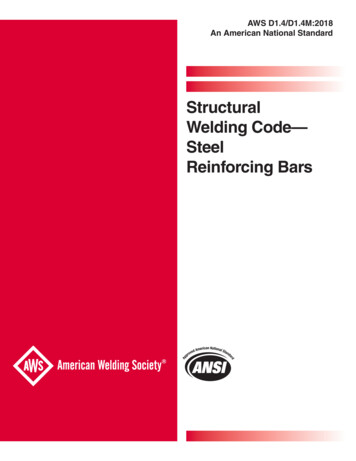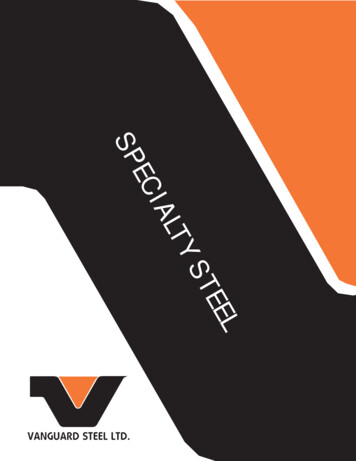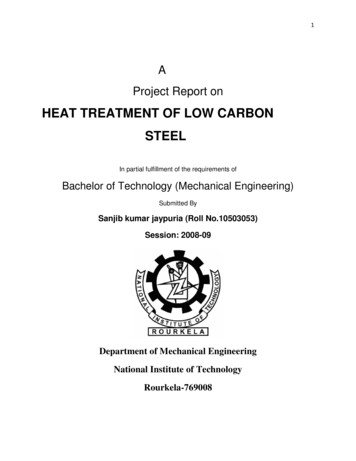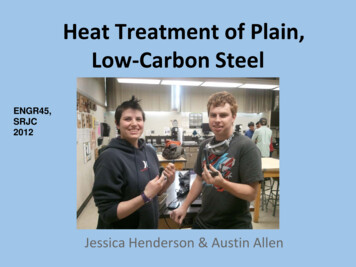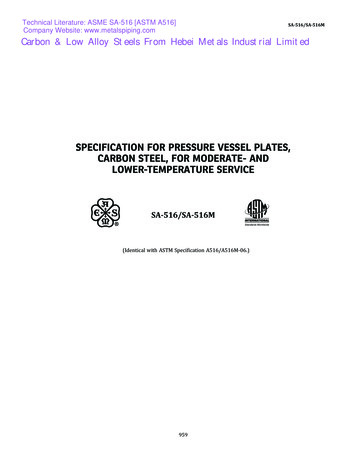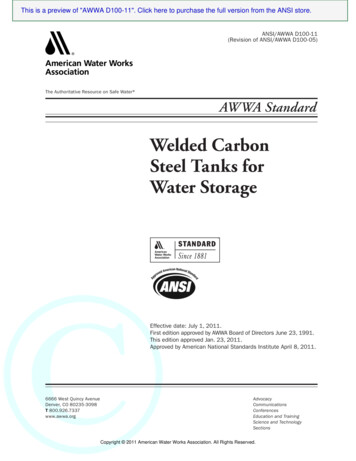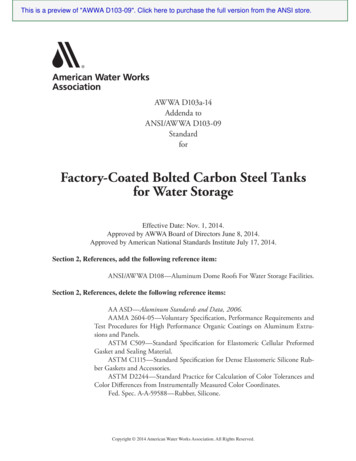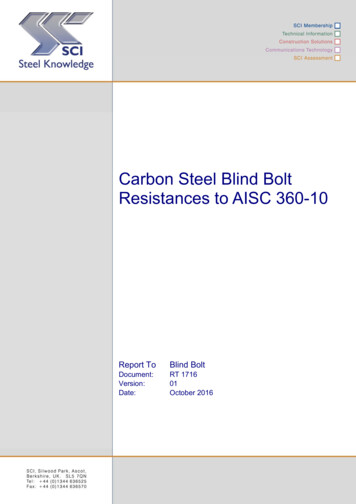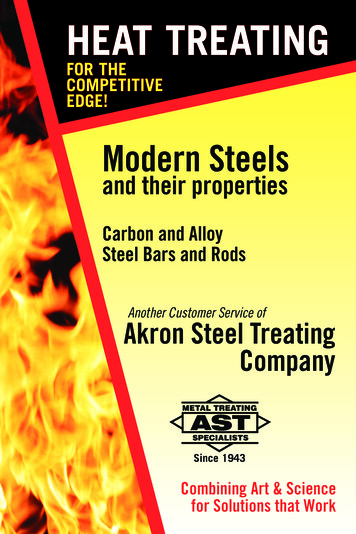
Transcription
Modern Steelsand their propertiesCarbon and AlloySteel Bars and RodsAnother Customer Service ofAkron Steel TreatingCompanySince 1943Combining Art & Sciencefor Solutions that Work
MTI STATEMENT OF LIMITED LIABILITY(Please Read Carefully)(Standards Adopted by the Metal Treating Institute, inc.)ALL WORK IS ACCEPTED SUBJECT TO THE FOLLOWING CONDITIONS:It is recognized that even after employing all the scientific methods known to us, hazards still remain in metal treating.THEREFORE, OUR LIABILITY SHALL NOT EXCEED TWICE THE AMOUNT OF OUR CHARGES FOR THE WORK DONE ONANY MATERIAL (FIRST TO REIMBURSE FOR THE CHARGES AND SECOND TO COMPENSATE IN THE AMOUNT OF THECHARGES), EXCEPT BY WRITTEN AGREEMENT SIGNED BY THE METAL TREATER.THE CUSTOMER, BY CONTRACTING FOR METAL TREATMENT, AGREES TO ACCEPT THE LIMITS OF LIABILITY AS EXPRESSED IN THIS STATEMENT TO THE EXCLUSION OF ANY AND ALL PROVISIONS AS TO LIABILITY ON THE CUSTOMER'SOWN INVOICES, PURCHASE ORDERS OR OTHER DOCUMENTS. IF THE CUSTOMER DESIRES HIS OWN PROVISIONS ASTO LIABILITY TO REMAIN IN FORCE AND EFFECT, THIS MUST BE AGREED TO IN WRITING. SIGNED BY AN OFFICER OFTHE TREATER. IN SUCH EVENT, A DIFFERENT CHARGE FOR OUR SERVICES, REFLECTING THE HIGHER RISK TO TREATER,SHALL BE DETERMINED BY TREATER AND CUSTOMER.THE TREATER MAKES NO EXPRESS OR IMPLIED WARRANTIES AND SPECIFICALLY DISCLAIMS ANY IMPLIED WARRANTY OF FITNESS FOR A PARTICULAR PURPOSE OR MERCHANTABILITY, AS TO THE PERFORMANCE OF CAPABILITIESOF THE MATERIAL AS HEAT TREATED, OR THE HEAT TREAMENT. THE AFOREMENTIONED UMITATION OF LIABILITY STATEDABOVE IS SPECIFICALLY IN LIEU OF ANY EXPRESS OR IMPLIED WARRANTY, INCLUDING ANY IMPLIED WARRANTY OFMERCHANTABILITY OR FITNESS, AND OF ANY OTHER SUCH OBLIGATION ON THE PART OF THE TREATER.No claims for shortage in weight or count will be entertained unless presented within five (5) working days after receiptof materials by customer. No claims will be allowed for shrinkage, expansion, deformity, or rupture of material in treatingor straightening, except by prior written agreement, as above, nor in any case for rupture caused by or.occurring during subsequent grinding. Whenever we are given material with detailed instructions as to treatment, our responsibility shall end withthe carrying out of those instructions. Failure by a customer to indicate plainly and correctly the kind of material (ialloy designation) to be treated, shall cause an extra charge to be made to cover any additional expense incurred as a result, properthereof, but shall not change the limitation of liability stated above.Customer agrees there will be no liability on the treater in contract or tort for any special, indirect or consequential damagesarising from any reason whatsoever, including but not limited to personal injury, property damage, loss of profits, loss ofproduction, recall or any other losses, expenses or liabilities allegedly occasioned by the work performed on the part of the treater.It shall be the duty of the customer to inspect the merchandise immediately upon its return, and in any eveht claims mustbe reported prior to the time that any further processing, assembling or any other work is undertaken.OUR LIABILITY TO OUR CUSTOMERS SHALL CEASE ONCE ANY FURTHER PROCESSING, ASSEMBLING OR ANY OTHERWORK HAS BEEN UNDERTAKEN ON SAID MATERIAL.No agent or representative is authorized to alter the conditions, except by writing duly signed by an officer of treater.Copyright 1987 Metal Treating Institute All rights reserved
HEAT TREATINGCAPABILITIESFOR THECOMPETITIVEEDGE!FURNACE TYPESComputer ControlledISO 9001:2000 & NadcapCERTIFICATIONSAerospace, Automotive andMilitary Qualified Vacuum/Nitrogen PressureQuench Integral Quench/Atmosphere Salt Bath Continuous ShakerHearth/Atmosphere-Oil Quench Intensive Water QuenchAMS-H-6875* (formerlyMIL-H-6875-H), AMS-2759**Certified to the most currentrevision of heat treatingspecificationsPROCESSESComputer ControlledAnnealingQUALITY CONTROL Certified JourneymenHeat Treaters Networked JobShoppe Computer Program for job trackingfrom receipt to delivery Certified testing andprocessing equipment Project tracking from receivingto delivery Spec-View Data Logging for100% traceability and permanentrecords Quality assured on every shipment Bright Full Homogenize IsothermalHardening Controlled Atmosphere Furnace-Air, Oil or Water Quench Vacuum/Controlled Gas Quench Neutral Salts BathAutomated HandlingAustemperingMarquenching Precipitation HardeningArtificial AgingCase Hardening Precision Gas CarburizingCarbonitridingFerritic NitrocarburizingCarbon RestorationThermal Treatment for PlasticsADDITIONAL SERVICES Black Oxide AMS 2485*MIL-DTL-13924* Deep Cryogenic to –300 Gauging and Sorting Laboratory TestingRockwell HardnessBrinell HardnessTukon Micro-HardnessMetallographicMicroscopeEngineering Assistance Tools Dies Plastic Molds Production Hardening Pick-up and DeliveryAvailableSince 1943With pride, we participatein these orgranizations.Akron SteelTreatingCompany336 Morgan AvenueAkron, OH 44311P.O. Box 2290Akron, OH 44309-2290330-773-8211Fax: 330-773-8213Toll Free: 1-800-364-ASTC(2782)Email: comCombining Art & Sciencefor Solutions that Work
ContentsMODERN STEELMAKINGRaw MaterialsBlast Furnace556Steelmaking MethodsThe Steel IngotTypes of Steel12Strand CastingVacuum Treatment6121415CARBON AND ALLOY STEELS 19Effects of Chemical Elements19AISI/SAE Standard Grades and Ranges 25HARDENABILITY OF STEEL43End-Quench Hardenability Testing44Calculation of Hardenability46Hardenability Limits Tables51THERMAL TREATMENT OF STEELConventional Quenching andTempering6161Isothermal TreatmentsSurface Hardening TreatmentsNormalizing and Annealing636671SAE Typical Thermal Treatments7481G RAI N SiZEMECHANICAL PROPERTIESOF CARBON AND ALLOY STEELSMACHINABILITY OF STEEL168NONDESTRUCTIVE EXAMINATIONUSEFUL DATA84173177GLOSSARY OF STEEL TESTINGAND THERMAL TREATING TERMS 191INDEX200
MODERNSTEELIVIAKINGSteel is essentially a combination of iron and carbon, the carboncontent of common grades ranging from a few hundredths to aboutone per cent. All steels also contain varying amounts of other elements, principally manganese, phosphorus, sulfur, and silicon, whichare always present if only in trace amounts. The presence andamounts of these and some 20 other alloying elements, which areadded in various combinations as desired, determine to a great extent the ultimate properties and characteristics of the particular steel.Raw MaterialsThe principal raw materials of the steel industry are iron ore,iron and steel scrap, coal, and limestone. Iron ore is a natural combination of iron oxides and other materials, such as silicon and phosphorus. Until recently, the industry's main sources of iron were thehigh-grade ores, containing from 55 to 65 per cent iron, which weremined and sent directly to the steel plants. Today, the most availabledomestic iron ore is taconite, which contains a lesser amount of iron,making its use uneconomical without some kind of beneficiation, aprocess in which the material is upgraded and formed into high-ironbearing pellets. Nearly one-half of the iron ore produced on this continent is now used in this pellet form.A second source of iron is scrap. Most of this comes from thesteel plant itself; only about two-thirds of the steel produced by steelplants is shipped as product, the remainder being discarded duringprocessing and returned to the furnaces as scrap. Other scrap, ifneeded, comes from outside the plant from such sources as old automobiles, worn out railway cars and rails, obsolete machinery, andcuttings from metalworking shops.
Coal is converted into coke, gas, and chemicals in the cokeovens. The coke is used in the blast furnace as a fuel and reducingagent, the gas is burned in heating units, and the chemicals are processed into various organic materials.Limestone is employed as a flux in both the blast furnace andsteelmaking furnace where it serves to remove impurities from themelt. It is used either as crushed stone direct from the quarry or, aftercalcining, as burnt lime.Blast FurnaceThe principal charging material used in making steel is moltenpig iron, the product of the blast furnace. To produce it, iron ore,coke, and limestone are charged into the top of the furnace. A continuous blast of preheated air, introduced near the bottom of the furnace, reacts with the coke to form carbon monoxide gas which thencombines with the oxygen in the iron oxides, thereby reducing themto metallic iron. The molten iron is tapped into a ladle for transportation to the steel producing unit.Pig iron contains considerable amounts of carbon, manganese,phosphorus, sulfur, and silicon. In the solid form, it is hard and brittleand therefore unsuitable for applications where ductility is important.S t e elm a king MethodsSteelmaking may be described as the process of refining pig ironor ferrous scrap by removing the undesirable elements from the meltand then adding the desired elements in predetermined amounts.These additions are often the same elements which were originallyremoved, the difference being that the elements present in the finalsteel product are in the proper proportion to produce the desiredproperties.The open-hearth, the basic oxygen, and the electric-arc processes account for nearly all the steel tonnage produced in this country today. The open-hearth furnace was the nation's major source ofsteel until 1969, when this role was assumed by the relatively newbasic oxygen process. Together, these two methods account for over80 per cent of the steel made in America. The remainder is made upof electric furnace steels.
VW.rU CHECKER :1:-TAP HOLELADLEIX CHAMBER:uz-m-1-1-1--i--1-SLAGGAS ORCHECKER1:TCHAMBER lEJitPOTxn-:-r-r- --m--m.Simplified cutaway diagram of a typical open-hearth furnace, equippedwith oxygen lance. Oxygen may be injected through one or more lances.OPEN-HEARTH FURNACE. The open-hearth furnace hasthe ability to produce steels in a wide range of compositions. Theprocess can be closely controlled, yielding steels of high quality fromcharges which need be only nominally restrictive in their analyses.Most modern open-hearth furnaces are lined with a chemically basicmaterial, such as magnesite, and use a basic refining slag. Furnacecapacities range from 100 to 500 tons per melt, or heat, each heatrequiring from 4 to 10 hours of furnace time.To begin the process, the basic open-hearth furnace is chargedwith scrap, limestone, and iron ore. This initial charge lies on an"open" hearth, where it is melted by exposure to flames sweepingover its surface. The pig iron, which may constitute as much as 75 percent of the charge, is added in the molten state after the scrap is partially melted. During the subsequent refining of the heata processwhich is frequently accelerated by the introduction of oxygen throughroof lances nearly all of the manganese, phosphorus, and siliconare oxidized and retained by the slag, which floats on the heaviermolten metal. Appreciable percentages of sulfur can also be takeninto the slag.
The heat is allowed to react until its carbon content has beenreduced by oxidation to approximately that desired in the finishedsteel. The furnace is then tapped, allowing the molten metal to flowinto a ladle. To obtain the desired analysis, appropriate quantities ofneeded elements, usually in the form of ferroalloys, are added to theheat as it pours into the ladle, or, in the case of some elements, addedto the furnace just prior to tapping. A deoxidizer, such as aluminumor ferrosilicon, is also normally added to control the amount of gasevolved during solidification (see p. 12). The heat is then usuallypoured into ingot molds where it solidifies into steel ingots.BASIC OXYGEN FURNACE. The "BOF" involves thesame chemical reactions as the open-hearth, but uses gaseous oxygenas the oxidizing agent to increase the speed of these reactions andthereby reduce the time of the refining process. Although the advantages of the use of oxygen were obvious to steelmakers a hundredyears ago, only in recent years has the pure gas become commerciallyavailable in the vast quantities required to make the BOF feasible.Heats of steel as large as 300 tons can be made in less than an hour,several times faster than the average open-hearth can operate. Thesteel is of excellent quality, equivalent to open-hearth steel in everyrespect.WATER COOLEDHOODST JSHELDuring the charging and tapping of theTAP BOF, the oxygen lance is raised and thet" HOLE vessel is tilted.REFRACTORYLINING
CD
The basic oxygen furnace, a closed-bottom, refractory-linedvessel, is charged with molten pig iron and scrap. During the oxygenblow, burnt lime and fluorspar, which form the slag, are charged intothe furnace. A high-velocity stream of oxygen is directed down ontothe charge through a water-cooled lance, causing the rapid oxidationof carbon, manganese, and silicon in the melt. These reactions provide the heat required for scrap melting, slag formation, and refining.Additions of deoxidizers and any required alloying elements aremade as the steel is tapped from the vessel into the ladle. It is thenusually poured into ingot molds, as with other steelmaking processes.In keeping with the industry's trend to use the most advancedtechnologies, the entire process is usually controlled by a computer.From data on the analysis and weights of the charge materials and ofmelt samplings, the computer quickly determines the precise amountsof the additive elements needed, as well as the cycle time required forthe refining operation.ELECTRIC-ARC FURNACE. Special steels, such as thehigh-alloy, stainless, and tool steels, are normally made in electricarc furnaces. The primary advantage of this type furnace is that itpermits the extremely close control of temperature, heat analysis,and refining condit
AMS-H-6875* (formerly MIL-H-6875-H), AMS-2759* *Certifi ed to the most current revision of heat treating specifi cations QUALITY CONTROL † Certifi ed Journeymen Heat Treaters † Networked JobShoppe Computer Program for job tracking from receipt to delivery † Certifi ed testing and processing equipment † Project tracking from receiving to delivery † Spec-View Data Logging for .
